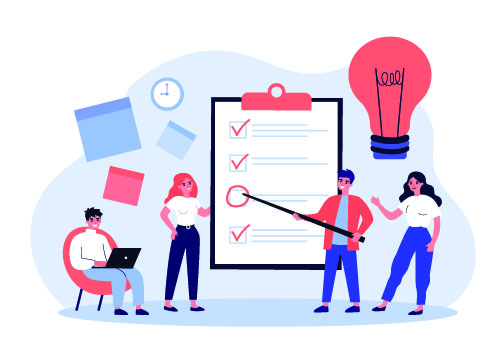
Surveys are a powerful tool for transforming business practices to better satisfy both clients and coworkers. For a B2B organization, surveys can be used for a variety of purposes and provide insight on customer satisfaction, market research, product feedback and company culture. However, creating an engaging survey with a high completion rate can be challenging. To navigate this challenge, we’re sharing our B2B survey best practices to help you gather clear and informative results.
Before Creation: Define Objectives
Before creating a survey, it is crucial to set an objective. What is the purpose and goal of your survey? Having a clearly defined objective will streamline the process of crafting questions.
When determining the objective of your survey, here are a few examples of focus areas:
- Product Preferences: When looking for new ideas for a product or service or wanting feedback on new ideas, your buyers are a great place to start. If your team is unsure which idea would resonate most, a survey is a great way to get feedback on the options and drive your strategy moving forward.
- Customer/Buyer Satisfaction: Understanding levels of customer satisfaction allows businesses to supplement effective tactics and modify those that are not appealing to customers. As new tactics are employed, you can continue to collect feedback and modify accordingly.
- Post Event: After your company has hosted or taken part in any event, a survey is a simple way to obtain attendee feedback. You can then use feedback from this event to evaluate strategies at future events and ensure as many attendees as possible have a positive experience. With guidance on how to execute a successful event, download our guide.
Once you’ve determined the direction you want to take, the process of creating survey questions can begin.
Creating the Survey
To ensure the audience completes the entire survey, keep questions focused and simple. Ideally, the survey should take no more than 3-5 minutes to complete. Any shorter than this and the survey may not collect enough information. Any longer than this and participants may start the survey but not complete it when they see there are too many questions to answer.
There are two basic types of questions that will appear in a survey: qualitative and quantitative.
- Qualitative questions are open-ended and require some type of original text response (e.g., “What did you enjoy about working with Launch Marketing?”).
- Quantitative responses, on the other hand, are answers that can be understood systematically, such as multiple-choice options.
When asking survey questions, whether it be closed or open-ended, avoid using confusing language. Ask specific and clear questions that are easy to understand so the respondent can answer without any issues.
Be sure to include an “N/A” option or an “Other” option with a text box to give your survey recipients additional opportunities to fill out your survey. This allows respondents to provide an answer that is more accurate to their own thoughts and opinions rather than forcing them to choose an answer that would not be reflective of them.
As for the flow of the survey, all questions should be grouped thematically. Keeping similar questions together allows participants to complete the survey more quickly. The first questions should be easy and engaging to entice audience members. Demographic information should come last, if necessary.
Distributing the Survey
Once the survey is complete, send it to a small test-group. Testing the survey allows for time to amend questions that the test-group found confusing or that led to unhelpful responses. This also allows time to work out any glitches with the access link or survey itself. After the survey is tested and proofed for errors by the test group, it can then be sent out to the intended recipients.
Send the survey to the right people by identifying the target audience. If the survey is about customer satisfaction or Net Promoter Score (NPS), it should go to all clients. Company cultured-based surveys should be sent to everyone involved with the company. Sending the survey to the target audience will provide the most valuable responses possible.
The survey should include a brief introduction of survey procedures—estimated completion time, if the responses are anonymous, why the survey is being conducted and if there are any incentives for completing the survey. Incentives are a great way to increase completion rates. Consider providing incentives to survey recipients such as a $5 Starbucks gift card, donation to a charity or a copy of the research findings upon completion.
When the survey is complete and the data has been compiled, follow up with respondents about the survey outcomes. Following up validates the relationship between company and customer and shows the respondents that their opinions make a difference. Additionally, customers will be more likely to answer surveys in the future.
Adhering to these procedures will maximize survey responses and provide clear results on a variety of business functions leading to happier clients and better business practices for all.
Tools to Get You Started
There are many survey tools available and it might be overwhelming to decide which one to use. Some surveys are free to use while others require a paid subscription. However, the most important thing to consider when deciding is to choose the tool that will meet all of your survey needs. For example, if you are looking to only use a free survey tool, make sure it can support the number of questions on your surveys, your distribution tactics and can generate any data you intend to collect. To get you started, here are a few tools:
Ready to Implement These B2B Survey Best Practices?
With these B2B survey best practices in hand, you will be well on your way to gathering insightful data that will take your content marketing efforts to the next level. If you would like further guidance or help to conduct your next survey, contact us or request a free marketing consultation to set your plans into motion!
There are no comments